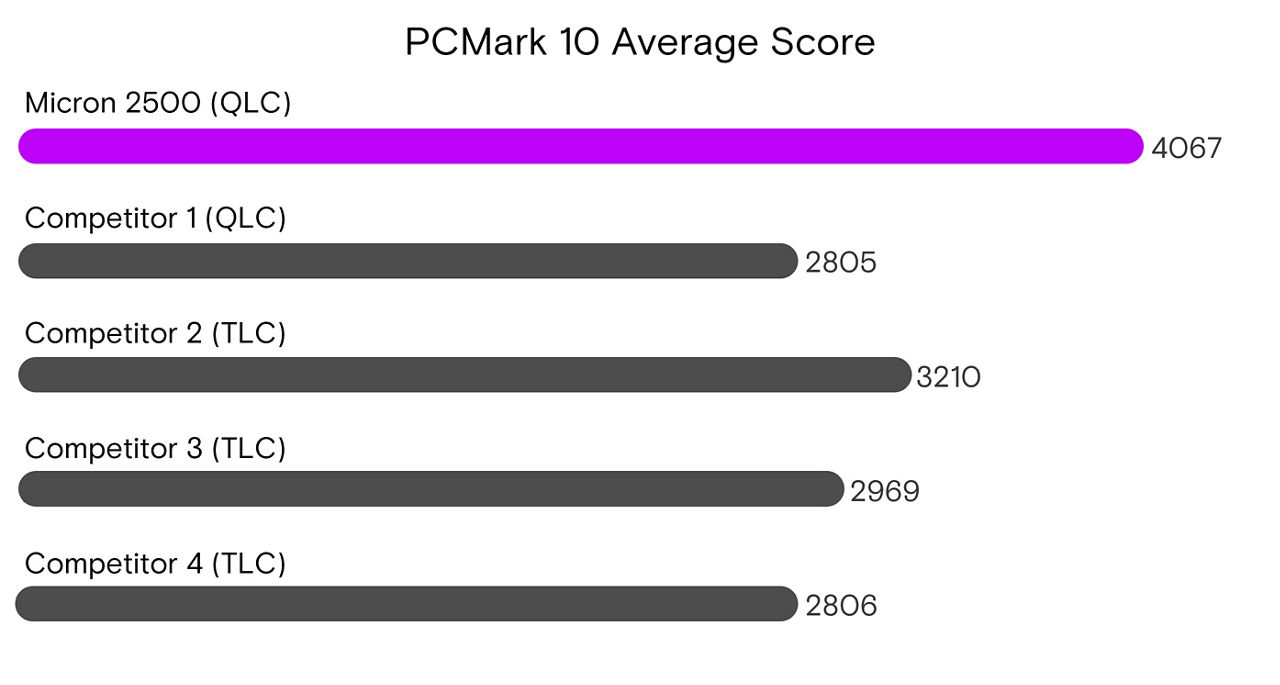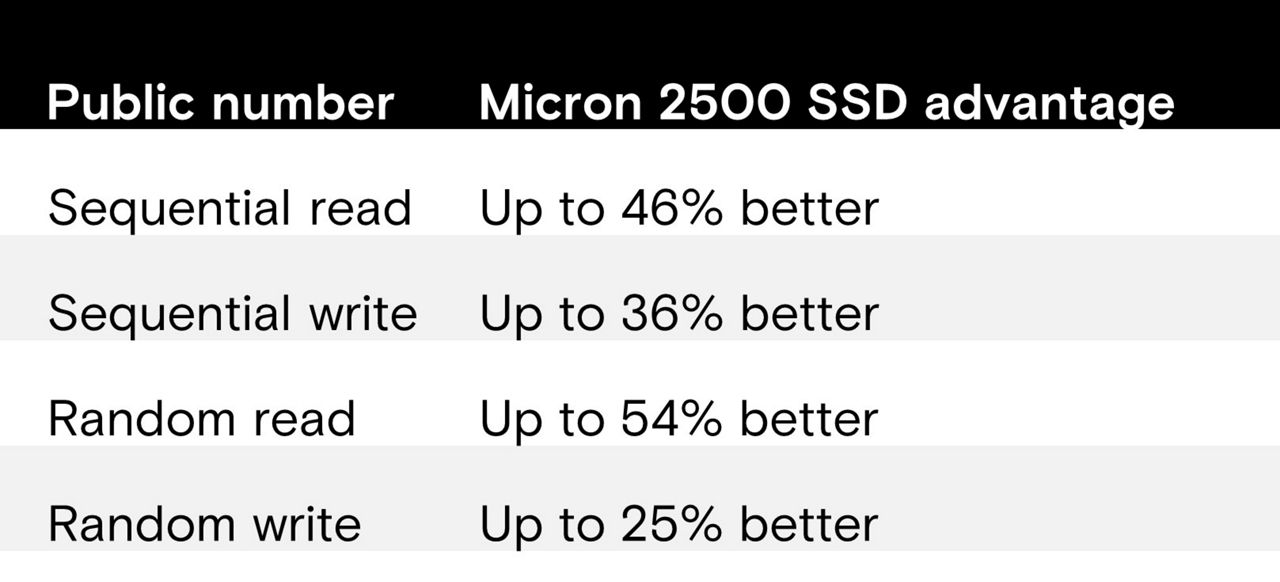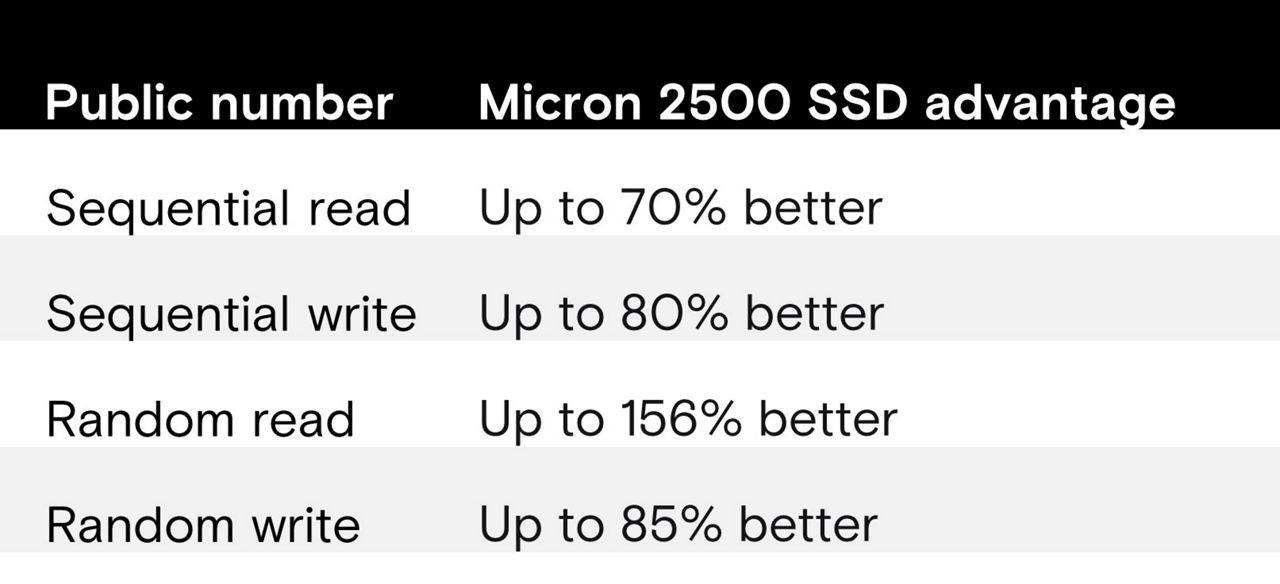Login / Register
Today is an important day, not just for Micron or for me (as a source of personal pride in my team), but for a broad range of users.
In my blog “The Micron 3500 SSD: A game-changer for pro games and professionals,” I noted how solid-state drives (SSDs) have become a pivotal component in an improved user experience on client devices and how those SSDs are tuned for specific uses, markets and users. There are client SSDs for performance (like the Micron 3500 SSD) and there are client SSDs aimed to strike a balance among features, performance and affordability.
A good example is the Micron 2500 SSD we announced today.
Our new client SSD addresses that necessary (and sometimes difficult to achieve) balance. To do this, we leveraged advanced Micron 232-layer QLC NAND and firmware to build an SSD with an unprecedented level of user experience and raw performance previously unavailable in value PCs.
User experience matters
Whether I’m speaking with a friend or addressing a large audience at an industry event, I often share what SSDs can do for them in the context of a common theme: User experience is what matters most. Sure, raw numbers, like we see in marketing pieces matter, too, and I’ll get to those in a bit.
But let’s start with how users perceive their systems. They tend to talk about a system’s “snappiness” or “responsiveness” or any of the other ways we describe user experience.
How can we measure user experience?
One great way to compare user experience is to rely on an industry-standard benchmark. A benchmark like PCMark® 10 (if you’re not familiar with it, visit the benchmark’s site) simulates common user tasks in productivity, content creation and gaming applications to measure how a user will experience system responsiveness.
Let’s take a look at how the Micron 2500 SSD compares to our competitors’ SSDs in the PCMark 10 Full System Drive Benchmark, as illustrated in the chart below. Higher values indicate a superior user experience:
Here we can see Micron’s cutting-edge 232-layer QLC NAND and firmware help the Micron 2500 SSD create a class-leading user experience.
What about the raw numbers?
OK, so we’ve seen that the Micron 2500 SSD excels in a standard benchmark designed to measure user experience (this testing was done in a lab). Comparing RAW numbers (marketing data, datasheet data, etc.) are much simpler and we don’t need a lab to do it. Since many customers use these numbers as a first comparison, let’s take a look at those.
Typical explicitly stated numbers are stated as:
- Sequential read
- Sequential write
- Random read
- Random write
Is it fair to compare the marketing numbers of a QLC SSD like the Micron 2500 to competitive TLC SSDs?
Well, it turns out that, against competitive TLC SSDs, the Micron 2500 SSD leads here, too.
Table 1: Marketing numbers, Micron 2500 QLC SSD vs. competitive TLC SSDs
Well, will the Micron 2500 SSD beat a competitive QLC SSD? In a word, yes.
Performance parity with TLC opens up new use cases
An SSD built with QLC NAND used to be performance disadvantaged. As we’ve clearly shown above, that historical disadvantage is simply gone with the Micron 2500 SSD. While some deltas remain, it’s now at parity with TLC for a wide variety of performance metrics. However, it is unparalleled against value SSDs when it comes to user experience as measured by PCMark 10.
Since QLC NAND stores 4 bits per cell, its inherent density helps drive both high capacity and small form factors. The Micron 2500 SSD offers up to 2TB in a small, 22 x 30mm M.2 form factor. How much storage is 2TB? About 34,000 hours of MP3 files or more than half a million photos.1 How small is a 22 x 30mm M.2 SSD? About the size of a small smartwatch. It fits in a Steam Deck.2 Small!
Why does Micron do this work?
Micron is committed to elevating the user experience for balanced SSDs. Why? Simple. Because it’s important. Here are a couple of examples:
In the article “Why SSDs matter: The importance of storage in student laptops,” the nonprofit Notebooks for Students noted that equipping students with devices that include SSDs brought several important benefits. In particular, the organization emphasized that faster system startup and application launch helped students power up more quickly and the SSDs enabled better multitasking and snappier performance for resource-intensive tasks.
Additional user benefits included superior longevity, resistance to shock, and better energy efficiency. These student-focused benefits available in price- and performance-balanced SSDs help broaden educational opportunities for all.
The Micron 2500 SSD has brought performance parity between QLC and TLC SSDs, leading the industry where it matters — in user experience and raw performance for balanced SSDs.
To learn more, look at our Micron 2500 SSD webpage. You’ll find additional resources to illustrate why the Micron 2500 SSD is an excellent choice. Then, ask your favorite OEM about which of its models use this SSD — it is shipping now!
1. See https://www.popularmechanics.com/technology/gear/a24604/worlds-highest-capacity-usb/ for additional information.
2. See https://www.theverge.com/2023/2/9/23593352/steam-deck-framework-2tb-m2-2230-ssd for additional information.



